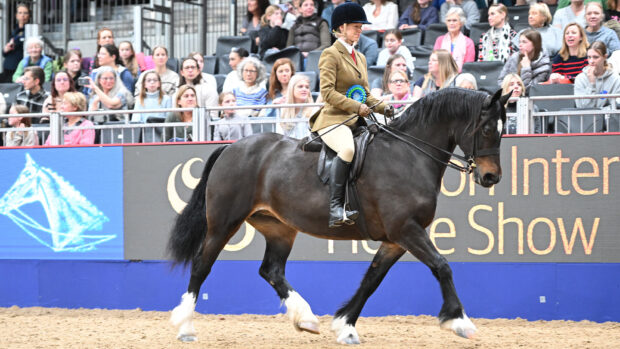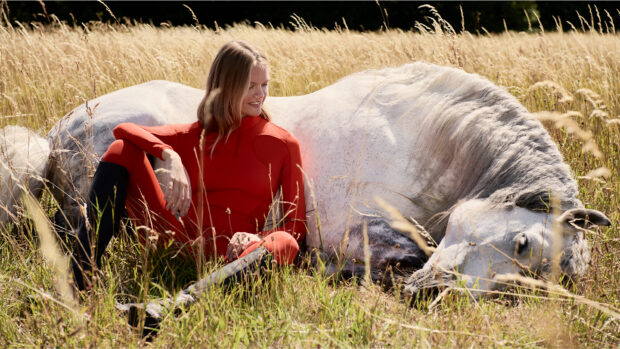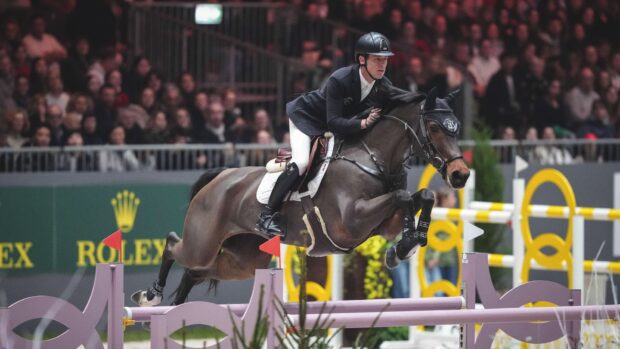Horse & Hound is supported by its audience. When you purchase through links on our site, we may earn commission on some of the items you choose to buy.
Learn more
Clicker training for horses relies on the concept of positive reinforcement. This method involves giving the horse something it enjoys – typically a treat or a scratch – after it performs a specific action, increasing the chances that the desired behaviour will be repeated. How to clicker train a horse requires great timing, and a few important bits of kit. It’s best to have a professional help set you on the right path, as – according to expert Lucy Chester – it’s “one of the hardest training methods to do well at the beginning”.
Lucy prescribes two exercises for starting clicker training.
How to clicker train a horse – the basics
{"content":"PC9wPgo8aDM+MS4gVGVhY2hpbmcgYSBob3JzZSB0aGUgbWVhbmluZyBvZiB0aGUgY2xpY2tlcjwvaDM+CjxkaXYgaWQ9ImF0dGFjaG1lbnRfODkzNjE1IiBzdHlsZT0id2lkdGg6IDE0MTBweCIgY2xhc3M9IndwLWNhcHRpb24gYWxpZ25ub25lIj48aW1nIGZldGNocHJpb3JpdHk9ImhpZ2giIGRlY29kaW5nPSJhc3luYyIgYXJpYS1kZXNjcmliZWRieT0iY2FwdGlvbi1hdHRhY2htZW50LTg5MzYxNSIgY2xhc3M9Imxhenlsb2FkIGJsdXItdXAgc2l6ZS1mdWxsIHdwLWltYWdlLTg5MzYxNSIgZGF0YS1wcm9jZXNzZWQgc3JjPSJodHRwczovL2tleWFzc2V0cy50aW1laW5jdWsubmV0L2luc3BpcmV3cC9saXZlL3dwLWNvbnRlbnQvdXBsb2Fkcy9zaXRlcy8xNC8yMDE3LzAzL25ldy1oaC1wbGFjZWhvbGRlci0yMDB4MjAwLnBuZyIgZGF0YS1zcmM9Imh0dHBzOi8va2V5YXNzZXRzLnRpbWVpbmN1ay5uZXQvaW5zcGlyZXdwL2xpdmUvd3AtY29udGVudC91cGxvYWRzL3NpdGVzLzE0LzIwMjUvMDUvSjdHNlhOLmpwZyIgYWx0PSJIb3cgdG8gY2xpY2tlciB0cmFpbiBhIGhvcnNlLCB3aXRoIGEgY2xpY2tlciIgd2lkdGg9IjE0MDAiIGhlaWdodD0iNzg4IiBkYXRhLXNpemVzPSJhdXRvIiBkYXRhLXNyY3NldD0iaHR0cHM6Ly9rZXlhc3NldHMudGltZWluY3VrLm5ldC9pbnNwaXJld3AvbGl2ZS93cC1jb250ZW50L3VwbG9hZHMvc2l0ZXMvMTQvMjAyNS8wNS9KN0c2WE4uanBnIDE0MDB3LCBodHRwczovL2tleWFzc2V0cy50aW1laW5jdWsubmV0L2luc3BpcmV3cC9saXZlL3dwLWNvbnRlbnQvdXBsb2Fkcy9zaXRlcy8xNC8yMDI1LzA1L0o3RzZYTi0zMDB4MTY5LmpwZyAzMDB3LCBodHRwczovL2tleWFzc2V0cy50aW1laW5jdWsubmV0L2luc3BpcmV3cC9saXZlL3dwLWNvbnRlbnQvdXBsb2Fkcy9zaXRlcy8xNC8yMDI1LzA1L0o3RzZYTi02MzB4MzU1LmpwZyA2MzB3LCBodHRwczovL2tleWFzc2V0cy50aW1laW5jdWsubmV0L2luc3BpcmV3cC9saXZlL3dwLWNvbnRlbnQvdXBsb2Fkcy9zaXRlcy8xNC8yMDI1LzA1L0o3RzZYTi0xMzV4NzYuanBnIDEzNXcsIGh0dHBzOi8va2V5YXNzZXRzLnRpbWVpbmN1ay5uZXQvaW5zcGlyZXdwL2xpdmUvd3AtY29udGVudC91cGxvYWRzL3NpdGVzLzE0LzIwMjUvMDUvSjdHNlhOLTMyMHgxODAuanBnIDMyMHcsIGh0dHBzOi8va2V5YXNzZXRzLnRpbWVpbmN1ay5uZXQvaW5zcGlyZXdwL2xpdmUvd3AtY29udGVudC91cGxvYWRzL3NpdGVzLzE0LzIwMjUvMDUvSjdHNlhOLTYyMHgzNDkuanBnIDYyMHcsIGh0dHBzOi8va2V5YXNzZXRzLnRpbWVpbmN1ay5uZXQvaW5zcGlyZXdwL2xpdmUvd3AtY29udGVudC91cGxvYWRzL3NpdGVzLzE0LzIwMjUvMDUvSjdHNlhOLTkyMHg1MTguanBnIDkyMHcsIGh0dHBzOi8va2V5YXNzZXRzLnRpbWVpbmN1ay5uZXQvaW5zcGlyZXdwL2xpdmUvd3AtY29udGVudC91cGxvYWRzL3NpdGVzLzE0LzIwMjUvMDUvSjdHNlhOLTEyMjB4Njg3LmpwZyAxMjIwdyIgc2l6ZXM9IihtYXgtd2lkdGg6IDE0MDBweCkgMTAwdncsIDE0MDBweCIgLz48cCBpZD0iY2FwdGlvbi1hdHRhY2htZW50LTg5MzYxNSIgY2xhc3M9IndwLWNhcHRpb24tdGV4dCI+QSBjbGlja2VyLCBhcyB1c2VkIGZvciBkb2dzIGFzIHdlbGwgYXMgaG9yc2VzLiBDcmVkaXQ6IEFsYW15PC9wPjwvZGl2Pgo8cD48c3Ryb25nPllvdSB3aWxsIG5lZWQ6PC9zdHJvbmc+PC9wPgo8cD48c2VjdGlvbiBpZD0iZW1iZWRfY29kZS0zMSIgY2xhc3M9ImhpZGRlbi1tZCBoaWRkZW4tbGcgcy1jb250YWluZXIgc3RpY2t5LWFuY2hvciBoaWRlLXdpZGdldC10aXRsZSB3aWRnZXRfZW1iZWRfY29kZSBwcmVtaXVtX2lubGluZV8yIj48c2VjdGlvbiBjbGFzcz0icy1jb250YWluZXIgbGlzdGluZy0tc2luZ2xlIGxpc3RpbmctLXNpbmdsZS1zaGFyZXRocm91Z2ggaW1hZ2UtYXNwZWN0LWxhbmRzY2FwZSBkZWZhdWx0IHNoYXJldGhyb3VnaC1hZCBzaGFyZXRocm91Z2gtYWQtaGlkZGVuIj4NCiAgPGRpdiBjbGFzcz0icy1jb250YWluZXJfX2lubmVyIj4NCiAgICA8dWw+DQogICAgICA8bGkgaWQ9Im5hdGl2ZS1jb250ZW50LW1vYmlsZSIgY2xhc3M9Imxpc3RpbmctaXRlbSI+DQogICAgICA8L2xpPg0KICAgIDwvdWw+DQogIDwvZGl2Pg0KPC9zZWN0aW9uPjwvc2VjdGlvbj48L3A+Cjx1bD4KPGxpPkVtcHR5IGJvd2w8L2xpPgo8bGk+Q2xpY2tlcjwvbGk+CjxsaT5EYW1wZW5lZCBjaGFmZiBvciBsb3ctdmFsdWUgcmVpbmZvcmNlcnMsIHN1Y2ggYXMgaGF5Y29icywgcHJlc3NlZCBoYXkgb3IgbWVhZG93IGdyYXNzPC9saT4KPGxpPkFsdGVybmF0aXZlIGZlZWQgc291cmNlIChzdWNoIGFzIGhheW5ldCB3aXRoaW4gcmVhY2gpIHNvIHlvdSBhcmUgbm90IHRoZSBvbmx5IHNvdXJjZSBvZiBmb29kPC9saT4KPC91bD4KPGRpdj4KPGRpdiBjbGFzcz0iZGVhbF9fYmxvY2siPgoJPGEgY2xhc3M9ImRlYWxfX2Jsb2NrLWltYWdlLWxpbmsiIGhyZWY9Imh0dHBzOi8vd3d3LmFtYXpvbi5jby51ay9BY2Vob21lLVRyYWluaW5nLUNsaWNrZXItRWZmZWN0aXZlLUJlaGF2aW9yYWwvZHAvQjA4RDNOMVJZMyIgdGFyZ2V0PSJfYmxhbmsiPgoJCTxkaXYgY2xhc3M9ImRlYWxfX2Jsb2NrLWltYWdlLWNvbnRhaW5lciI+CgkJCTxpbWcgZGVjb2Rpbmc9ImFzeW5jIiBjbGFzcz0iZGVhbF9fYmxvY2staW1hZ2UgbGF6eWxvYWQgYmx1ci11cCAiIGRhdGEtc3JjPSJodHRwczovL2tleWFzc2V0cy50aW1laW5jdWsubmV0L2luc3BpcmV3cC9saXZlL3dwLWNvbnRlbnQvdXBsb2Fkcy9zaXRlcy8xNC8yMDIzLzAyL0NsaWNrZXItMTAxeDEwMC5qcGciIHNyYz0iaHR0cHM6Ly9rZXlhc3NldHMudGltZWluY3VrLm5ldC9pbnNwaXJld3AvbGl2ZS93cC1jb250ZW50L3VwbG9hZHMvc2l0ZXMvMTQvMjAxNy8wMy9uZXctaGgtcGxhY2Vob2xkZXItMjAweDIwMC5wbmciLz4KCQk8L2Rpdj4KCTwvYT4KCTxwPjxzdHJvbmc+VHdvIHBhY2sgY2xpY2tlciB3aXRoIHdyaXN0IHN0cmFwIOKAkyDCozMuOTUgYXQgYW1hem9uLmNvLnVrPC9zdHJvbmc+PGJyIC8+CkF2YWlsYWJsZSBpbiBhIHdpZGUgcmFuZ2Ugb2YgY29sb3VycywgdGhlc2UgY2xpY2tlcnMgaGF2ZSBhIGxhcmdlIGJ1dHRvbiBmb3IgZWFzZSBvZiB1c2UgYW5kIGNhbiBiZSBhdHRhY2hlZCB0byB5b3VyIHdyaXN0LCBiZWx0IGxvb3Agb3IgYmFnLjwvcD4KCgk8cD48YSBjbGFzcz0iZGVhbF9fYmxvY2stYnV0dG9uIiBocmVmPSJodHRwczovL3d3dy5hbWF6b24uY28udWsvQWNlaG9tZS1UcmFpbmluZy1DbGlja2VyLUVmZmVjdGl2ZS1CZWhhdmlvcmFsL2RwL0IwOEQzTjFSWTMiIHRhcmdldD0iX2JsYW5rIj5WaWV3IE5vdzwvYT48L3A+CjwvZGl2Pgo8L3A+CjxkaXY+CjxzdHJvbmc+U2V0LXVwPC9zdHJvbmc+PC9wPgo8cD5QaWNrIGEgcXVpZXQgcGxhY2Ugd2hlcmUgdGhlIGhvcnNlIGlzIHJlbGF4ZWQuPC9wPgo8cD5FaXRoZXIgd29yayBiZWhpbmQgcHJvdGVjdGVkIGNvbnRhY3Qg4oCTIGEgYmFycmllciBzdWNoIGFzIGEgZmVuY2Ugb3IgYSBzdGFibGUgZG9vciDigJMgb3IgdGllIHlvdXIgaG9yc2UgdXAgd2l0aCBhIGhheW5ldCwgaWYgdGhleSBhcmUgaGFwcHkgdG8gYmUgdGllZC4gVHJ5IHRvIHN0YXkgYSBzaG9ydCBkaXN0YW5jZSBhd2F5IHNvIHRoZXkgY2Fubm90IHJlYWNoIHlvdSB0byBzbnVmZmxlIHlvdXIgcG9ja2V0cy48L3A+CjxwPjxzdHJvbmc+U2hhcGluZyBwbGFuPC9zdHJvbmc+PC9wPgo8dWw+CjxsaT5DbGljayBhbmQgcHV0IGEgaGFuZGZ1bCBvZiBjaGFmZiBvciBhIGZldyBoYXkgcGVsbGV0cyBpbnRvIHRoZSBidWNrZXQuPC9saT4KPGxpPkJlZm9yZSB0aGUgaG9yc2UgZmluaXNoZXMgdGhlIGZvb2QsIGNsaWNrIGFuZCBhZGQgbW9yZS4gVGhpcyB0ZWFjaGVzIHRoZW0gdGhhdCB0aGUgY2xpY2sgY29tZXMgYmVmb3JlIHRoZSBmb29kLjwvbGk+CjxsaT5SZXBlYXQgdW50aWwgdGhlaXIgZWF0aW5nIHJhdGUgc2xvd3MgZG93bi4gVGhleSB3aWxsIG1ha2UgdGhlIGNvbm5lY3Rpb24gYmV0d2VlbiB0aGUgY2xpY2sgYW5kIHRoZSByZXdhcmQgdmVyeSBxdWlja2x5ICg8YSBocmVmPSJodHRwczovL3d3dy5ob3JzZWFuZGhvdW5kLmNvLnVrL2ZlYXR1cmVzL2NsYXNzaWNhbC1jb25kaXRpb25pbmctZm9yLWhvcnNlcy04ODczMDMjOn46dGV4dD1JZiUyMHRoZSUyMGhvcnNlJTIwaXMlMjBwdXQsdCUyMGJlJTIwcHV0JTIwdW5kZXIlMjBwcmVzc3VyZS4iIHRhcmdldD0iX2JsYW5rIiByZWw9Im5vZm9sbG93IG5vb3BlbmVyIj5jbGFzc2ljYWwgY29uZGl0aW9uaW5nPC9hPikuPC9saT4KPGxpPkFmdGVyIGFib3V0IDEwIHJlcGV0aXRpb25zLCBnaXZlIGFuIGV4dHJhIGJpZyBoYW5kZnVsIHRvIHRoZSBmb29kLCB0aGVuIHJldHJlYXQgYW5kIGFsbG93IHRoZSBob3JzZSB0byBmaW5pc2ggZWF0aW5nLiBUaGlzIHdpbGwgcHJldmVudCB5b3UgZnJvbSBtb3ZpbmcgaW50byB0aGUgbmVnYXRpdmUgcHVuaXNobWVudCB0cmFpbmluZyBxdWFkcmFudCAoYnkgdGFraW5nIHRoZSBmb29kIGF3YXkpLjwvbGk+CjwvdWw+CjxwPk9uY2UgdGhlIGhvcnNlIHVuZGVyc3RhbmRzIHRoYXQgdGhlIGNsaWNrIGlzIGZvbGxvd2VkIGJ5IHRoZSBhcnJpdmFsIG9mIGEgbG93LXZhbHVlIGZvb2QgcmV3YXJkIGluIHRoZSBidWNrZXQsIHlvdSBjYW4gbW92ZSBvbiB0byB0aGUgbmV4dCB0YXNrLjwvcD4KPGgzPjIuIFRlYWNoaW5nIGEgaG9yc2UgdG8gdG91Y2ggYSBjb25lPC9oMz4KPGRpdiBpZD0iYXR0YWNobWVudF84OTM2MTgiIHN0eWxlPSJ3aWR0aDogMTQxMHB4IiBjbGFzcz0id3AtY2FwdGlvbiBhbGlnbm5vbmUiPjxpbWcgZGVjb2Rpbmc9ImFzeW5jIiBhcmlhLWRlc2NyaWJlZGJ5PSJjYXB0aW9uLWF0dGFjaG1lbnQtODkzNjE4IiBjbGFzcz0ibGF6eWxvYWQgYmx1ci11cCBzaXplLWZ1bGwgd3AtaW1hZ2UtODkzNjE4IiBkYXRhLXByb2Nlc3NlZCBzcmM9Imh0dHBzOi8va2V5YXNzZXRzLnRpbWVpbmN1ay5uZXQvaW5zcGlyZXdwL2xpdmUvd3AtY29udGVudC91cGxvYWRzL3NpdGVzLzE0LzIwMTcvMDMvbmV3LWhoLXBsYWNlaG9sZGVyLTIwMHgyMDAucG5nIiBkYXRhLXNyYz0iaHR0cHM6Ly9rZXlhc3NldHMudGltZWluY3VrLm5ldC9pbnNwaXJld3AvbGl2ZS93cC1jb250ZW50L3VwbG9hZHMvc2l0ZXMvMTQvMjAyNS8wNS9LMkZNOTcuanBnIiBhbHQ9IlRyYWluaW5nIGNvbmVzIGNhbiBiZSB1c2VkIGZvciBob3cgdG8gY2xpY2tlciB0cmFpbiBhIGhvcnNlIiB3aWR0aD0iMTQwMCIgaGVpZ2h0PSI3ODgiIGRhdGEtc2l6ZXM9ImF1dG8iIGRhdGEtc3Jjc2V0PSJodHRwczovL2tleWFzc2V0cy50aW1laW5jdWsubmV0L2luc3BpcmV3cC9saXZlL3dwLWNvbnRlbnQvdXBsb2Fkcy9zaXRlcy8xNC8yMDI1LzA1L0syRk05Ny5qcGcgMTQwMHcsIGh0dHBzOi8va2V5YXNzZXRzLnRpbWVpbmN1ay5uZXQvaW5zcGlyZXdwL2xpdmUvd3AtY29udGVudC91cGxvYWRzL3NpdGVzLzE0LzIwMjUvMDUvSzJGTTk3LTMwMHgxNjkuanBnIDMwMHcsIGh0dHBzOi8va2V5YXNzZXRzLnRpbWVpbmN1ay5uZXQvaW5zcGlyZXdwL2xpdmUvd3AtY29udGVudC91cGxvYWRzL3NpdGVzLzE0LzIwMjUvMDUvSzJGTTk3LTYzMHgzNTUuanBnIDYzMHcsIGh0dHBzOi8va2V5YXNzZXRzLnRpbWVpbmN1ay5uZXQvaW5zcGlyZXdwL2xpdmUvd3AtY29udGVudC91cGxvYWRzL3NpdGVzLzE0LzIwMjUvMDUvSzJGTTk3LTEzNXg3Ni5qcGcgMTM1dywgaHR0cHM6Ly9rZXlhc3NldHMudGltZWluY3VrLm5ldC9pbnNwaXJld3AvbGl2ZS93cC1jb250ZW50L3VwbG9hZHMvc2l0ZXMvMTQvMjAyNS8wNS9LMkZNOTctMzIweDE4MC5qcGcgMzIwdywgaHR0cHM6Ly9rZXlhc3NldHMudGltZWluY3VrLm5ldC9pbnNwaXJld3AvbGl2ZS93cC1jb250ZW50L3VwbG9hZHMvc2l0ZXMvMTQvMjAyNS8wNS9LMkZNOTctNjIweDM0OS5qcGcgNjIwdywgaHR0cHM6Ly9rZXlhc3NldHMudGltZWluY3VrLm5ldC9pbnNwaXJld3AvbGl2ZS93cC1jb250ZW50L3VwbG9hZHMvc2l0ZXMvMTQvMjAyNS8wNS9LMkZNOTctOTIweDUxOC5qcGcgOTIwdywgaHR0cHM6Ly9rZXlhc3NldHMudGltZWluY3VrLm5ldC9pbnNwaXJld3AvbGl2ZS93cC1jb250ZW50L3VwbG9hZHMvc2l0ZXMvMTQvMjAyNS8wNS9LMkZNOTctMTIyMHg2ODcuanBnIDEyMjB3IiBzaXplcz0iKG1heC13aWR0aDogMTQwMHB4KSAxMDB2dywgMTQwMHB4IiAvPjxwIGlkPSJjYXB0aW9uLWF0dGFjaG1lbnQtODkzNjE4IiBjbGFzcz0id3AtY2FwdGlvbi10ZXh0Ij5UcmFpbmluZyBjb25lcyBjYW4gYmUgdXNlZCBmb3IgY2xpY2tlciB0cmFpbmluZyDigJMgYmx1ZSBhbmQgeWVsbG93IGFyZSByZWNvbW1lbmRlZCBhcyB0aGV5IGFyZSBlYXNpZXN0IGZvciB0aGUgaG9yc2UgdG8gc2VlLiBDcmVkaXQ6IEFsYW15PC9wPjwvZGl2Pgo8cD48c3Ryb25nPllvdSB3aWxsIG5lZWQ6PC9zdHJvbmc+PC9wPgo8cD5FdmVyeXRoaW5nIGxpc3RlZCBhYm92ZSwgcGx1cyBhIGNvbmUgb3Igb3RoZXIgbWFya2VyLjwvcD4KPHA+PHN0cm9uZz5TZXQtdXA8L3N0cm9uZz48L3A+CjxwPkFzIGFib3ZlPC9wPgo8cD48c3Ryb25nPlNoYXBpbmcgcGxhbjwvc3Ryb25nPjwvcD4KPHA+SG9sZCBhIGNvbmUgKG9yIG90aGVyIG1hcmtlcikgdXAgZm9yIHlvdXIgaG9yc2UgdG8gdG91Y2ggd2l0aCB0aGVpciBub3NlLiBIb3JzZXMgYXJlIG5hdHVyYWxseSBjdXJpb3VzIHNvIHVzdWFsbHkgd2lsbCBidXQgaWYgdGhleSBkb27igJl0LCB5b3UgY2FuIHB1dCBpdCBvbiB0aGUgZmxvb3Igb3IgZXZlbiByZXdhcmQgdGhlbSBmb3IgbG9va2luZyBhdCBpdCB0byBiZWdpbiB3aXRoLiBUaGVuIGNsaWNrIGFuZCBwdXQgYSBmZXcgaGF5Y29icyBpbiB0aGUgYnVja2V0LiBVc2luZyBhIHllbGxvdyBvciBibHVlIGNvbmUgKG9yIG90aGVyIG1hcmtlcikgd2lsbCBoZWxwIGFzIGhvcnNlcyBoYXZlIGRpY2hyb21hdGljIHZpc2lvbjsgdGhleSBzZWUgY2xlYXJseSBzaGFkZXMgb2YgeWVsbG93IGFuZCBibHVlLjwvcD4KPHA+UmVwZWF0IHRocmVlIHRvIGZpdmUgdGltZXMsIHRoZW4gYWRkIGEgaGFuZGZ1bCBvZiBmb29kIGludG8gdGhlIGJvd2wgYW5kIHN0ZXAgYXdheSB0byBnaXZlIHRoZSBob3JzZSBhIGJyZWFrLiBJdOKAmXMgaW1wb3J0YW50IHdpdGggcG9zaXRpdmUgcmVpbmZvcmNlbWVudCBub3QgdG8gdXNlIG5lZ2F0aXZlIHB1bmlzaG1lbnQgYWNjaWRlbnRhbGx5IGJ5IHRha2luZyBmb29kIGF3YXkgZnJvbSB0aGUgaG9yc2UuPC9wPgo8cD5XaGVuIHRoZSBob3JzZSB1bmRlcnN0YW5kcyB0byB0b3VjaCB0aGUgY29uZSwgeW91IGNhbiBhZGQgdGhlIHZvaWNlIGN1ZSDigJx0b3VjaOKAnSwgdGhlbiBvbmx5IHJld2FyZCAoY2xpY2ssIHRoZW4gZmVlZCkgd2hlbiB5b3UgaGF2ZSBnaXZlbiB0aGUgaG9yc2UgdGhlIGN1ZSAoc3RpbXVsdXMgY29udHJvbCkuPC9wPgo8cD5UcnkgdG8gYXZvaWQgZnJ1c3RyYXRpb24sIGJlIGNsZWFyIHdpdGggeW91ciBhc2tzIGFuZCBpbmNsdWRlIGJyZWFrcyB3aGVuIHlvdSBwdXQgZm9vZCBpbiB0aGUgYm93bCwgdGhlbiByZXRyZWF0LiBNYWtlIHN1cmUgeW91IGRvIHRoaXMgd2hlbiB5b3UgZmluaXNoIHRyYWluaW5nIHRvby48L3A+CjxwPkx1Y3kgYWRkczog4oCcVGhlc2UgYXJlIG15IHR3byBmb3VuZGF0aW9uIGV4ZXJjaXNlcyBiZWZvcmUgdGVhY2hpbmcgaG9yc2VzIGhvdyB0byB0YWtlIGZvb2QgZnJvbSBteSBoYW5kLCBmaXJzdCB3aXRoIHRoZSBiYXJyaWVyLCB0aGVuIHdpdGhvdXQuPC9wPgo8cD7igJxZb3UgY2FuIGF2b2lkIG5lZ2F0aXZlIHB1bmlzaG1lbnQgYW5kIGZydXN0cmF0aW9uIGJ5IGFsd2F5cyBsZWF2aW5nIHRoZSBob3JzZSB3aXRoIGZvb2QgYmVmb3JlIHlvdSBsZWF2ZS48L3A+CjxwPuKAnE9uY2UgdGhlIGhvcnNlIHVuZGVyc3RhbmRzIHdoYXQgdGhlIGNsaWNrZXIgbWVhbnMgYW5kIGhvdyB0byBiZSBjYWxtIGFyb3VuZCBmb29kLCB0aGUgc2t5IGlzIHRoZSBsaW1pdCHigJ08L3A+Cg=="}
Did you enjoy this article? You may also like to read…
Credit: Alamy Stock Photo
Understanding how horses learn can help to you to build a bond with your horse.
Credit: Alamy Stock Photo
A stroke on the neck is more effective than a pat when used as positive reinforcement while training horses.
Credit: Lucy Merrell
H&H recommends wearing gloves while doing groundwork with horses.
Credit: Alamy Stock Photo
Confidence and experience are essential for handling horses when they are fresh or spooky.
Credit: Philip Barker










